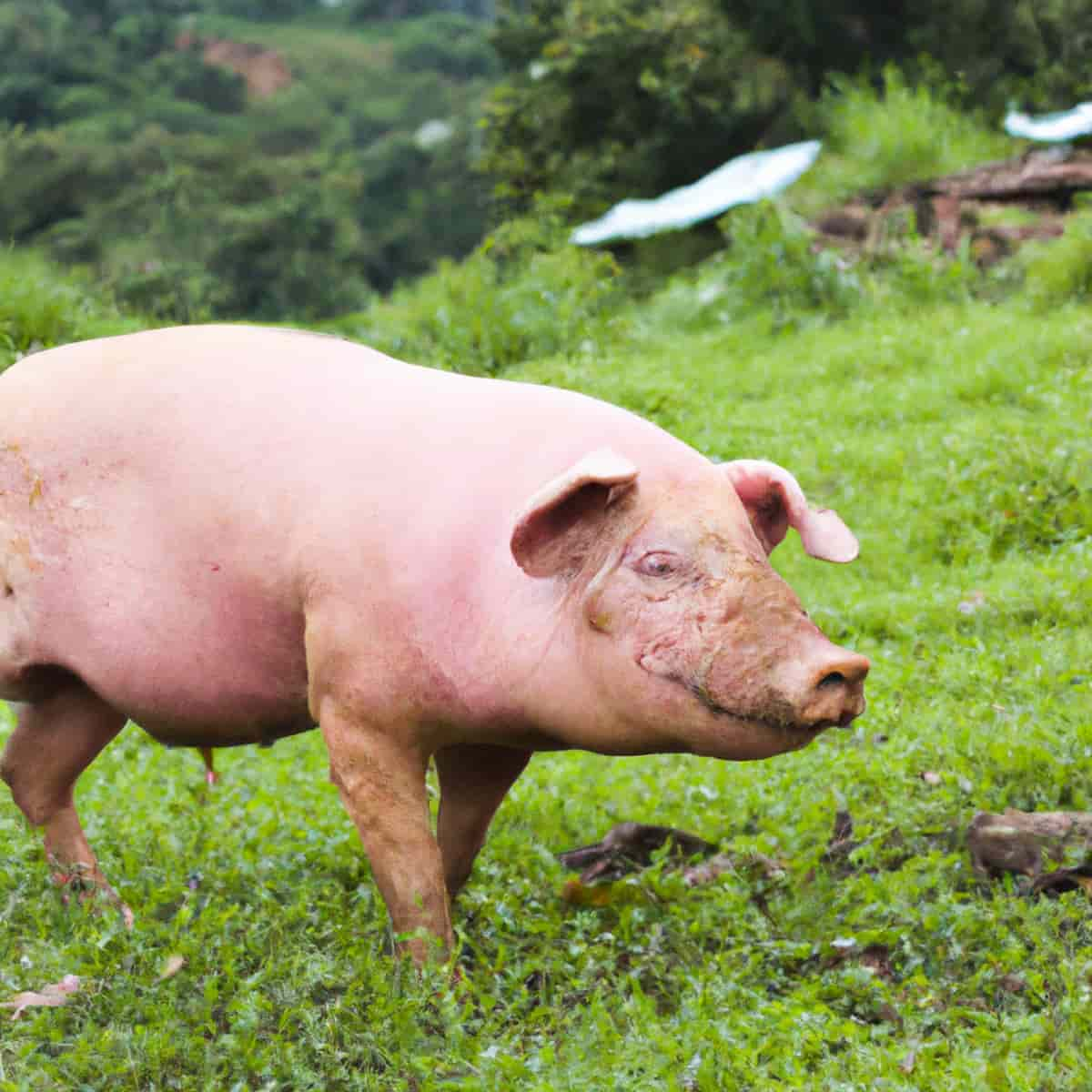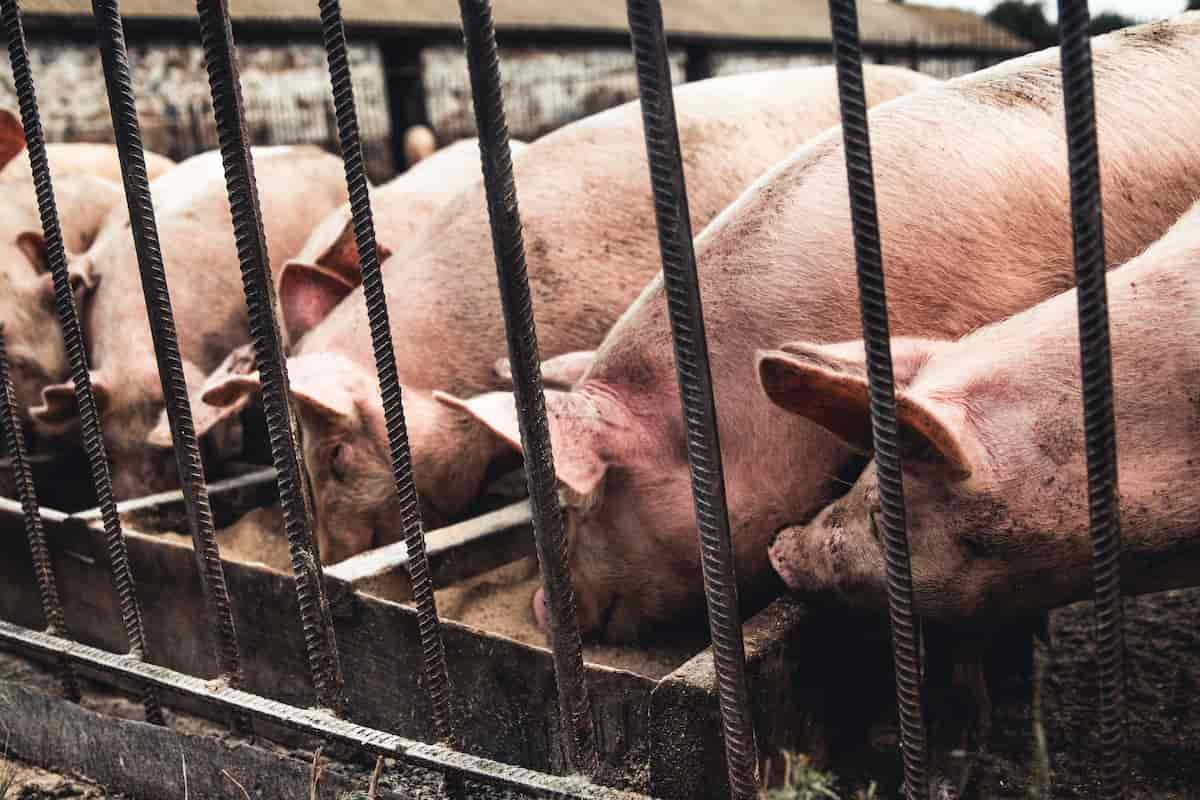Pigs are susceptible to many diseases, some of which can be highly contagious and cause significant economic losses to pig farmers. Below we learn about common swine diseases and treatment, prevention of pig diseases, and bacterial and viral diseases caused by pigs. Here are the top 10 pig diseases, along with their symptoms, causes, preventions, and control measures:

Top 10 Pig Diseases
African Swine Fever (ASF)
- Symptoms: fever, loss of appetite, vomiting, diarrhea, internal bleeding, skin discoloration, and death.
- Causes: a highly contagious viral disease that can be spread through direct contact with infected pigs or contaminated materials.
- Preventions: maintaining strict biosecurity measures, controlling wild pig populations, and not feeding pigs with waste food.
- Control: quarantine and culling of infected pigs, disinfection of contaminated areas, and vaccination where available.
Porcine Reproductive and Respiratory Syndrome (PRRS)
- Symptoms: respiratory distress, fever, lethargy, and reproductive failure in sows.
- Causes: a viral disease that can be spread through contact with infected pigs or contaminated materials.
- Preventions: maintaining strict biosecurity measures, testing and quarantining new pigs, and disinfecting all surfaces and equipment.
- Control: vaccination of sows and piglets, culling of infected pigs, and disinfection of contaminated areas.
Porcine Epidemic Diarrhea (PED)
- Symptoms: severe diarrhea, vomiting, dehydration, and death in young piglets.
- Causes: a highly contagious viral disease that can be spread through direct contact with infected pigs or contaminated materials.
- Preventions: maintaining strict biosecurity measures, testing and quarantining new pigs, and disinfecting all surfaces and equipment.
- Control: vaccination where available, quarantine and culling of infected pigs, and disinfection of contaminated areas.
Swine Influenza (Flu)
- Symptoms: fever, coughing, sneezing, runny nose, and lethargy.
- Causes: a viral disease that can be spread through contact with infected pigs or contaminated materials.
- Preventions: maintaining strict biosecurity measures, testing and quarantining new pigs, and disinfecting all surfaces and equipment.
- Control: vaccination where available, quarantine and culling of infected pigs, and disinfection of contaminated areas.
Porcine Circovirus Type 2 (PCV2)
- Symptoms: Wasting, respiratory distress, and diarrhea in young piglets; reproductive failure in sows.
- Causes: a viral disease that can be spread through contact with infected pigs or contaminated materials.
- Preventions: maintaining strict biosecurity measures, testing and quarantining new pigs, and disinfecting all surfaces and equipment.
- Control: vaccination where available, quarantine and culling of infected pigs, and disinfection of contaminated areas.
Salmonellosis
- Symptoms: fever, diarrhea, vomiting, and dehydration.
- Causes: a bacterial disease that can be spread through contaminated feed or water.
- Preventions: maintaining strict biosecurity measures, avoiding feeding pigs with waste food, and ensuring a clean and hygienic environment.
- Control: use of antibiotics, quarantine and culling of infected pigs, and disinfection of contaminated areas.
In case you missed it: Top 10 Chicken Diseases: Symptoms, Causes, Preventions, and Control

Erysipelas
- Symptoms: fever, skin lesions, arthritis, and sudden death in severe cases.
- Causes: a bacterial disease that can be spread through contaminated feed or water.
- Preventions: maintaining strict biosecurity measures, avoiding feeding pigs with waste food, and ensuring a clean and hygienic environment.
- Control: use of antibiotics, quarantine and culling of infected pigs, and disinfection of contaminated areas.
Foot-and-Mouth Disease (FMD):
- Symptoms: blisters on the tongue, mouth, and hooves, and lameness in infected pigs.
- Causes: A viral infection that spreads through direct contact with infected pigs, contaminated equipment, or feed.
- Preventions: Biosecurity measures such as controlling access to pig farms, disinfecting equipment and clothing, and using only heat-treated feed. Vaccines are available for FMD.
- Control: Culling infected pigs, disposal of carcasses, and strict quarantine measures.
Porcine Parvovirus (PPV):
- Symptoms: reproductive failure, fetal death, mummification, stillbirths, and weak piglets.
- Causes: A viral infection that spreads through direct contact with infected pigs, contaminated equipment, or feed.
- Preventions: Biosecurity measures, vaccination, and strict feed and water quality control.
- Control: Isolation of infected pigs and strict cleaning and disinfection of affected areas.
Brucellosis
- Symptoms: abortion, infertility, stillbirths, and weak piglets. Infected pigs may also show fever, anorexia, and weight loss.
- Causes: A bacterial infection that spreads through ingestion of contaminated feed, water, or aborted fetuses.
- Preventions: Biosecurity measures, vaccination, and strict feed and water quality control.
- Control: Isolation of infected pigs and strict cleaning and disinfection of affected areas. Infected pigs must be culled and disposed of properly.
Frequently Asked Questions About Pig Rearing Diseases
What is the Most Common Disease in Pigs?
The most common disease in pigs is Porcine reproductive and respiratory syndrome (PRRS). It is caused by a virus that affects both pigs’ respiratory and reproductive systems, leading to respiratory distress, reproductive failure, and poor growth performance. PRRS is highly contagious and can spread rapidly between pigs and through indirect contact with contaminated equipment or personnel.
The disease is particularly challenging to control due to the ability of the virus to mutate, leading to the emergence of new strains. Prevention and control of PRRS rely on biosecurity measures, vaccination, and appropriate management practices, such as the early detection and isolation of infected pigs. Effective management of PRRS is crucial for the sustainability and profitability of pig farming, as it can result in significant economic losses due to decreased productivity and increased veterinary costs.
What are the Symptoms of Pig disease?
The symptoms of pig diseases can vary depending on the type of disease, the infection’s severity, and the pig’s age and breed. Some common symptoms of pig diseases include fever, loss of appetite, coughing, diarrhea, lethargy, and difficulty breathing. Skin lesions, lameness, and reproductive problems are common symptoms of some diseases. Pigs may also show behavioral changes, such as aggression or withdrawal when sick.
In case you missed it: Top 10 Shrimp/Prawn Diseases: Symptoms, Causes, Prevention, and Control

It is important for farmers and caretakers to monitor their pigs closely for any signs of illness and seek veterinary attention promptly if they suspect a disease. Early detection and treatment of pig diseases can prevent further spread and minimize the economic losses associated with illness and death.
Conclusion
In conclusion, properly understanding and managing pig diseases are essential for successful pig farming. Timely diagnosis and treatment of pig diseases can prevent economic losses and ensure the health and welfare of the pigs.
To prevent and control these diseases, farmers should implement appropriate biosecurity measures, vaccination programs, and proper management practices, such as regular cleaning and disinfection of the pig house, appropriate feeding, and good hygiene. In addition, farmers must work with veterinarians and animal health experts to develop a comprehensive disease control program for their pig farms.
- Feed Your Flock for Less: Top 10 Tips to Save on Chicken Feed
- Ultimate Guide to Ossabaw Island Hog: Breeding, Raising, Diet, and Care
- Hatching Answers: The Top 10 Reasons Your Chickens Aren’t Laying Eggs
- Eggs and Economics: Breaking Down the Cost of Raising Backyard Chickens
- Defend Your Greens: Proven Methods to Keep Iguanas Out of Your Garden
- Ultimate Guide to Cinnamon Queen Chicken: A Comprehensive Guide for Beginners
- Ultimate Guide to California Tan Chicken: Breeding, Raising, Diet, Egg-Production and Care
- Ultimate Guide to Marsh Daisy Chicken: Breeding, Raising, Diet, and Care
- 10 Types of Chicken Farming Businesses You Can Start for Profits